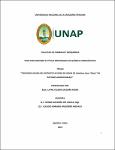Toxicidad aguda del extracto acuoso de hojas de Calathea lutea bijao en ratones albinos BALB/C
Abstract
El presente trabajo de investigación tuvo como objetivo determinar la toxicidad aguda del extracto acuoso de hojas de Calathea lutea “bijao” en ratones albinos Mus musculus Balb/C”. El estudio experimental, prospectivo, transversal, tuvo como muestra animal a 12 ratones albinos Balb/C del sexo macho repartidos en grupo control negativo y 3 grupos experimentales a los cuales, previo ayuno, se les administró una dosis única por vía oral de extracto acuoso de hojas de Calathea lutea “bijao” a una dosis de 25 mg/kg, 200 mg/kg y 2 000 mg/kg respectivamente. Se registró el peso corporal de los ratones el día uno, siete y catorce. Los resultados más importantes encontrados fueron: un 7,23% de rendimiento por cada 100 g. de hoja seca. Durante el tiempo de experimentación se mostró un aumento de aproximadamente 17,52% del peso promedio del primer al séptimo día, y una disminución de aproximadamente 15,42% del peso promedio del séptimo al décimo cuarto día. En cuanto a la observación macroscópica de toxicidad aguda de los órganos y sistemas, se evidenció sedación leve a nivel de comportamiento en todos los grupos, y a nivel cutáneo y del sistema autónomo, pilo erección leve a la dosis de 200 mg/kg peso corporal. Asimismo, se evidenció agrandamiento hepático en los grupos 2 (200 mg/kg) y predominancia en el 3 (2000 mg/kg P.C) con una variación de 1,97 g en el peso entre los grupos, significando un aumento de aproximadamente el 80% del basal y el 30% del peso corporal total del ratón. Por lo cual, se puede concluir que el extracto acuoso de hojas de Calathea lutea “bijao” presenta un posible efecto toxico o nocivo en los animales de experimentación (a dosis de 2000 mg/kg) al manifestarse alteraciones clínicas significativas al nivel hepático observados en comparación con el grupo control negativo. The objective of the present investigation was to determine the acute toxicity of the aqueous extract of Calathea lutea "bijao" leaves in albino mice Mus musculus Balb/C ". It was an experimental study, of the prospective, transversal type. It had as animal sample of 12 male Balb/C albino mice, distributed a negative control group and 3 experimental groups previous fasting the aqueous extract was administered orally at a single dose of leaves of Calathea lutea “bijao” was administered 25 mg/kg, 200 mg/kg and 2000 mg/kg dose. The body weight of the mice was recorded on day one, seven and fourteen. The most important results were: We obtained a 7,23% yield per 100 g. of dry leaf. During the experimentation time, an increase of approximately 17, 52% of the average weight was observed from the first to the seventh day, and a decrease of approximately 15, 45% of the average weight from the seventh to the fourteenth day. Regarding the macroscopic observation of acute toxicity of the organs and systems, mild sedation was observed at the behavioral level in all groups, and mild erection was observed at the cutaneous and autonomous systems at a dose of 200 mg/kg body weigth. Likewise, hepatic enlargement was evident in group 2 (200 mg/kg) and predominance in 3 (2000 mg/kg doses) with a variation of 1,97 g in weight between the groups, meaning an increase of approximately 80% of the basal and 30% of the total body weight of the mouse. Therefore, it can be concluded that the aqueous extract of Calathea lutea “bijao” leaves present a possible toxic or noxious effect in the experimental animals when significant clinical alterations were observed at the hepatic level compared to the negative control group.
Collections
- Tesis [299]
The following license files are associated with this item:


